As flappers donned their frills,
And bootleggers hid their stills,
Clint and Bertha hopped into their Velie,
and headed for Brown's Valley.
This was the place they could call home,
And where their chickens would roam...
Bertha Rose Bayles was born in Pagosa Springs, Colorado January 1, 1900. She was the youngest daughter of Morton and Emma Macht Bayles.
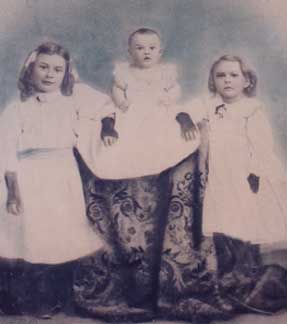
Maud, Bertha, and Florence Bayles
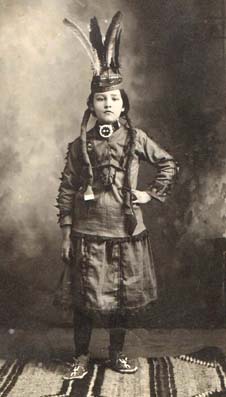
Native American heritage has been suggested on the Bayles side of the family
Following graduation from high school, she attended Fort Lewis Girls School. She and her mother eventually moved to Chama, New Mexico to join her sister and brother-in-law, Florence and John Rippy. She worked as a clerk in the post office there.
George Clinton Manchester was born in Sierraville, California in 1886 to Myron D. and Eva Abbe Manchester. He attended Horace Mann School in San Francisco.
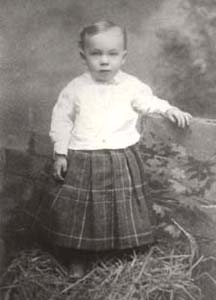

Before WWI, Clint enlisted in the Army and was stationed at the Presidio in San Francisco. He was a bugler. After his enlistment ended, he went to work for the Standard Oil Company on their wildcat wells in New Mexico. When the war began, he tried to reenlist but was told they needed him more in the oil fields.
In New Mexico, he and his fellow crew members liked to make wagers when they knew a new gal was coming to wait tables in the oil field. They would ride out and bet as to who would see her first. That person would be the one to pursue her as a girlfriend. One day, as Clint and some others were riding towards the oil field his grey horse, on its own accord, took off and went up to the top of a hill. This is where he first spotted Bertha who was out horseback riding. This is when he said she would be his girl.
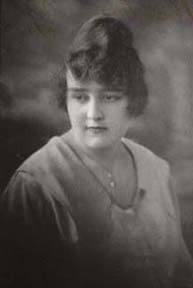
Shortly after that encounter, Clint moved to the Fellows/Taft area of California to work in the oil fields. Bertha and her mother moved to Fellows to join her brother, Howard, who also worked in the fields and knew Clint. A dinner date was set up for Clint and Bertha. She did not want to go because she didn't know how to act on a dinner date. She was so shy. They made her go and she made the best of it. She did exactly what Clint did - picked up her fork when he did, used the finger bowl when he did, etc. In 1922, they made a decision to elope. One night, Clint drove his beautiful Velie automobile to the house when Bertha's mother was asleep. He accidentally hit the house with his car waking her mother. They went on their way and were married.
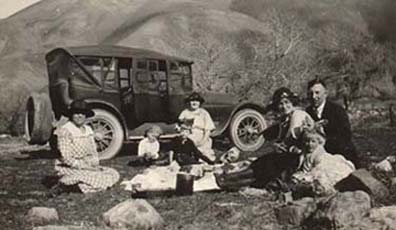
Bertha and mother, Emma, picnicking with the Manchester family with Velie in background
The next year, they were thinking of buying property in Santa Cruz County. Clint read an article in one of his chicken magazines about a man named George Burhman, who had Wyandotte chickens in Corralitos. They decided to drive up to his place to see the chickens. He told them he had property for sale with a house on Brown's Valley Road (133). When they saw the place they knew this was where Clint would raise his chickens. They named it Cal-Col Poultry Ranch (California and Colorado).

Manchester home on Brown's Valley Road (133)
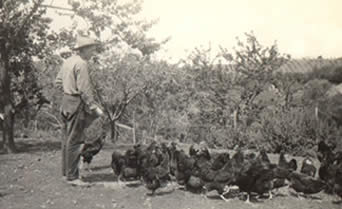
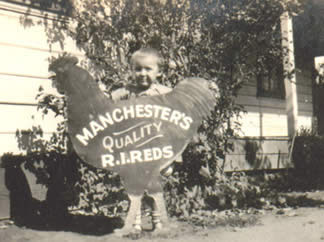
Their daughter, Gwendolyn, was born in 1925. That year, Bertha's family, Florence and John and their three children, Eva, Leslie and Norma moved to Corralitos. Her oldest sister, Maud Diehl, died from pneumonia, so Clint and Bertha helped with the care of her two daughters, Dorothy and Margaret. Emma Bayles moved to Watsonville, and eventually to Corralitos to be cared for by her two daughters. When Bertha's niece, Eva, was learning to talk she called her aunt, Bobo. From then on, she was fondly called Bobo as well as Bertha.
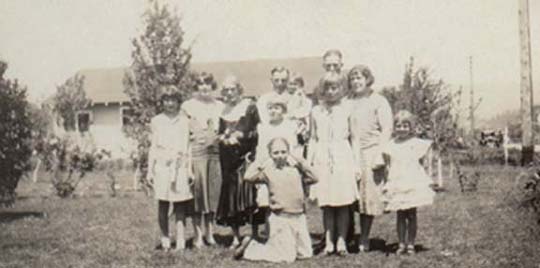
1927 Manchesters with the Rippy family
John and Clint cut a road through to the lower part of the property (the road between 115 and 129) where they built a small house by the creek for the Rippy family. Both families lived on the property until the early 1940s, when Clint and Bobo bought the house at 12 Aldridge Lane. The Rippy family moved to 115 Brown's Valley then bought the house at 547 Corralitos Road where their middle daughter and her family live today.
Earl Lemon, who in 1937 had built the garage building at the corner of Corralitos Road and Schoolhouse Lane (Aldridge), offered Clint an area of the building for a grocery store. Clint's Grocery was started in 1939 with about $10 worth of groceries. Both Bobo and Clint ran the store and the gas pumps in front of the store. They opened early, sometimes 6:00 a.m., and closed late. Stocked shelves lined the walls with lower shelves in the center of the room. There was a floor level glass case at the end of the counter for candy and gum. A meat counter was in the rear corner. Gwen worked at the store, too, while she was going to school. After she married, they remodeled the back storage area (video store currently) for Gwen to have a gift shop. They closed the store in the mid-fifties.

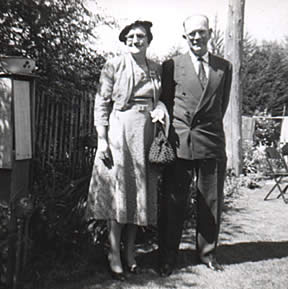
Earl and Vila Lemon

Hazel Bradley Johnson and her family lived across Aldridge Lane from Clint's Grocery. She recalled: “One day when Leland, my youngest son, was very little, I sent him to Clint's for three doughnuts. He couldn't remember so I put his little finger down and put his thumb on it and told him there were three fingers left. He hurried across the road with his little hand held up. In a few minutes, I got a call from Clint to ask me if I wanted three or four doughnuts. He said Leland was saying he wanted three but he was holding up four fingers. When Clint explained it to him, Leland told him he stepped in a hole on his way to the store and his finger slipped and he couldn't get it back. Bobo and Clint also used to let my older son, Norman, sit over behind the magazines and read the funny books as long as he kept them nice and neat. Then when he got tired he would come home. It was a really nice, safe place for him to be. After the store closed the kids played in there. One day they came home with two dusty jars of honey that had been left behind. They thought they had found a real treasure. I sat the jars in warm water because the honey had solidified. When it melted down, we sat around and ate honey.”
Both Clint and Bobo were community-minded people. Clint worked for a time at the school as bus driver and custodian. They both helped organize the Grange in Corralitos in 1932 and had a big part in the fundraisers and construction of the Grange Hall. Clint was the first Master at the new building. Along with the offices he held, he also was in charge of the ladies drill team. It was surely his sense of humor that decided the men folk should have a “drill team” as well.

LtoR George Johnson, George Olmstead, Ray Brodin, Earl Reid, Archie Schmidt, John Rippy, Clint, Roy Stump, and John (Pete) Peterson
In 1940, a volunteer fire department was organized and Clint was elected chief. In 1942, he organized a rural militia for the community. The men met and had outside drills on Aldridge Lane by his store. During WWII, he also, worked as a guard at the shipyards in San Francisco. Bobo volunteered time to sit at the Civil Defense building on the hill off Hames Road to record aircraft. In the late 1940's the Manchesters purchased property up Eureka Canyon on Buzzard Lagoon Road. They enjoyed entertaining, so this larger house suited their needs much better. Eventually, they had a magnificent flower garden with fruit trees and a beautiful patio area for outside parties. A path led down from the back of the property through the ferns and redwoods to a natural spring. They built a house next to the existing garage across the road from their house for Gwen and her family. They had a group of nearby neighbors that they referred to as “Lagoonites”. Family and friends had many memorable occasions at “The Ranch” during the years the Manchesters lived there.

Buzzard Lagoon Road

The Manchester ranch house

1957 The Lagoonites includes Clint and Bertha, Joe and Ellen Cutler, Don and Gloria Nohrden, Anna and Earl Smith, Grace and Cal Bucher, Mrs. Olson and son, Otto
It was 1962 when they moved back to 12 Aldridge. Bobo had been employed at the Corralitos School (Bradley) in the cafeteria. There are many people around today that still remember Hazel Bradley and Bobo's “famous” spaghetti served for hot lunches and for spaghetti feeds.

During their retirement years, they traveled more often with friends. They both continued to participate in the community and entertain at their home. As well as being charter members of the Grange, Clint was a Corralitos Padre, a storyteller and a poet, while Bobo enjoyed playing Bridge and gardening. They lived out their lives as the Manchesters of Corralitos.
| During her years in Corralitos, Bobo made scrapbooks of news articles, cards, events of family, friends and the community. It was these scrapbooks that inspired the book Corralitos. |

1979 Bobo |
|
